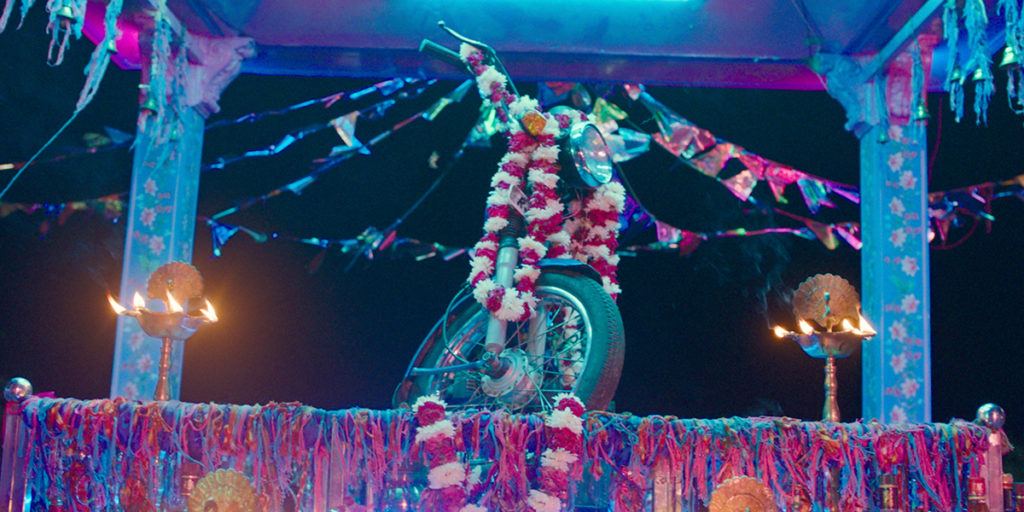Dug Dug

Image courtesy TIFF.
Lit by the pastel glow of a latticed canopy of pink and blue LED lights, Thakur Lal (Altaf Khan) leaves what looks to be a bar, in a giddy, seemingly enlightened state of almost religious ecstasy. Almost. He caps off a bottle that, soon to be apparent, isn’t filled with water. He somehow manages to make it down the highway to the back roads where he topples in front of a Billboard that reads “Jagar!” (“wake up” in Hindi) and depicts the face of a magician’s face looming over a sawed woman trick. Just when we think he’s ok, a truck runs him over, splitting him in two like the woman on the sign.
After the police impound the motorcycle, the next day it goes missing, until they find it mysteriously returned to the billboard. They chain the bike, it returns to the billboard. They put it behind bars, it still finds its way back. So, the senior officer, Manfool (Durga Lal Saini), tells his junior officers, Pyare Lal (Gaurav Singh) and Badri (Yogendra Singh), “God only knows what games he plays. Everything is his will.”
While Manfool laments not having any serious crimes to solve, Pyare Lal tells him, “Ekdum, chup! (Shut up, now!).”
Pyare in particular struggles to reconcile his belief in the divine with his misfortunes. He and his wife have been trying, without luck, to conceive. As you can surmise, if the motorcycle is the MacGuffin, the inconceivable is Chekhov’s Gun.
Whilst trying to make sense of the situation, the Commissioner (Rajesh Kumar Goswami) shows up at their outpost to conduct an inspection. As the inquiry into the seemingly supernatural affair expands, each official in this Holy Telephone game bureaucratically delegates (read: abdicates) down the line until there’s no one left.
Is the bike cursed? Did someone take the bike? Does it matter? Soon, the villagers gather and discuss the religious implications in an informal style that’s very typical of Hindu rites. During prayers (puja) led by a Brahmin priest you might see him break into asides, explaining different aspects of these millennia-old rituals.
A word about that billboard, though. It’s very common for dangerous roads in India to be adorned with signs every so often to keep drivers alert. They’ll often feature darkly comic aphorisms or warnings. I saw many such signs on my return to my birthplace in Kashmir, on dangerous switchback passes in the Himalayas. Omens are a part of every superstitious society, but in the developing market of India, the traditionally anti-materialist principles of Hinduism are drowned out by a class-exploitative obsession likened to American Christianity’s so-called Prosperity movement—led by megachurch pastors such as Houston’s Joel Osteen.
As this mystery finds its way out of the hands of the police and into the villagers’, it grows a life of its own. Soon, politicians, businessmen, and priests are all over it, erecting a motorcycle shrine, then schools, hospitals, and a temple, in the name of Thakur Sa.
Directed by Ritwik Pareek DUG DUG (Hindi slang for “motorcycle” evoking the sound it makes) casts a satirical lens on belief and class, but in a very Indian way that respects the roots of belief whilst criticizing its fruits.
There’s a recurring image in the film, of a herder filling up a pink and blue balloon. Hindu festivals—Diwali, Holi, Kukur Tihar, among others—often involve lively pigments. The pink and blue colors of Saint Thakur (taken from his motorcycle) signify, respectively, prosperity and holiness—attributes which, taken in moderation, aren’t necessarily bad. The second of the four phases (ashrama) of life is that of the householder—building stability and prosperity for a time, before casting off these illusions and renouncing materialism in the latter stages of life.
Taken in moderation, these stages fulfill various societal roles. But taken to excess, they lead to ruin. In trying to maintain that balance, however, is where the film falls short. Due to extensive censorship, movies like this can’t risk being bluntly critical of political, legal, and theological corruption. They cajole their way around it. Consequently, the editor employs hip-hop montage far too often as extensive filler in place of addressing the nagging question inside Pyare Lal’s heart or the systemic corruption of all levels of Indian politics and law enforcement infrastructure, both of which maintain the status quo of caste inequality and religious dogma that contributes to the country’s anti-Muslim fervor.
In the final scene, we do achieve a kind of enlightenment in the sense that we finally discover the truth the motorcycle has to offer. But we never really see karma play out. Under the conservative eye of government censorship, leaves the real religious fanaticism of Modi’s India unexamined, we’re left wondering when this ever-expanding balloon of blissful ignorance will burst.